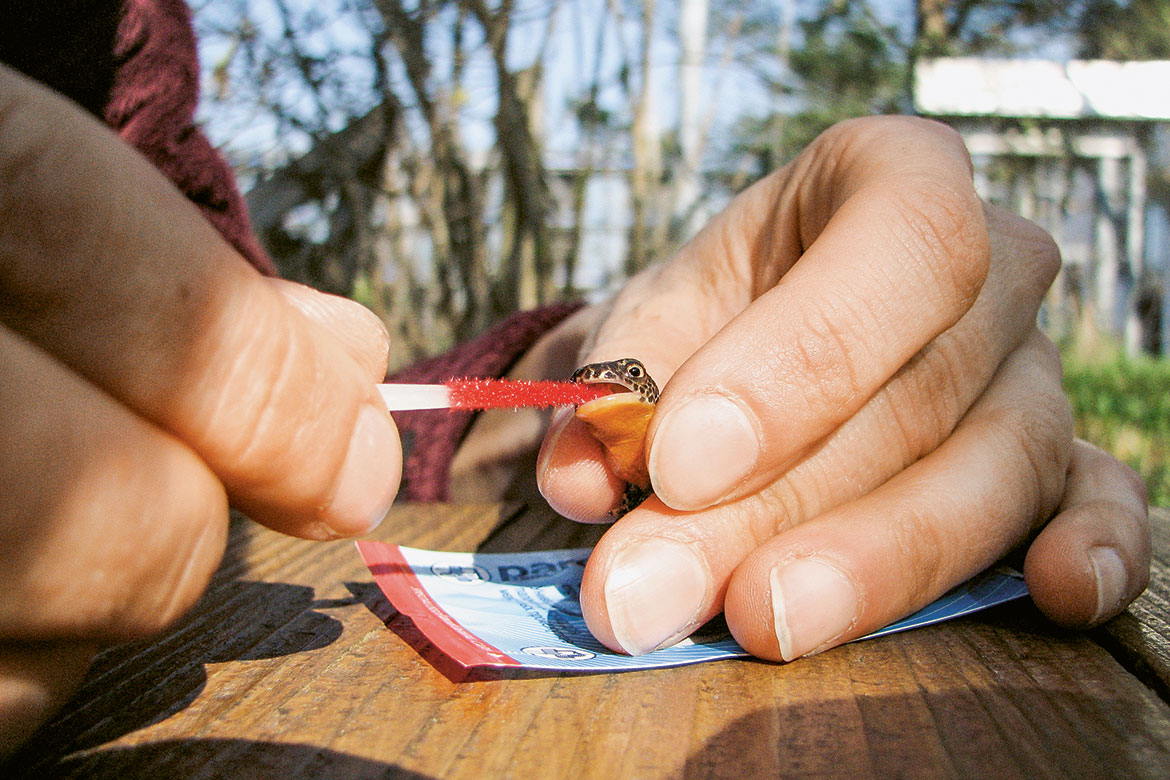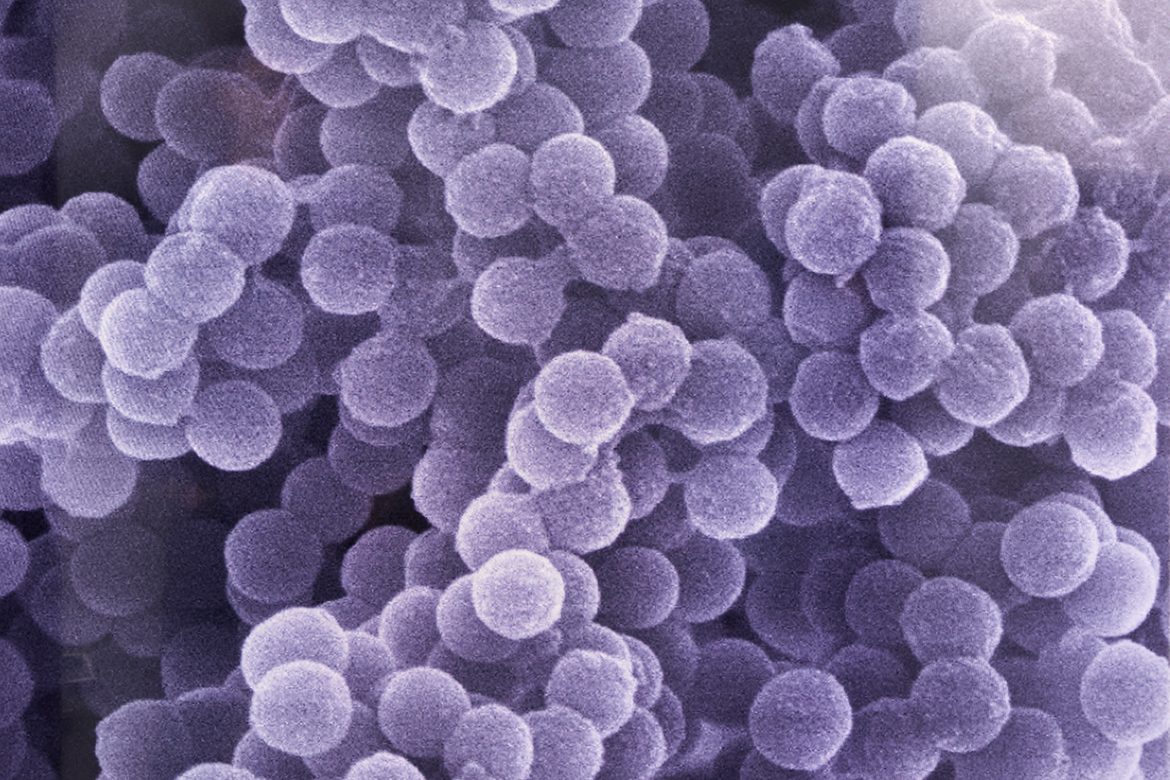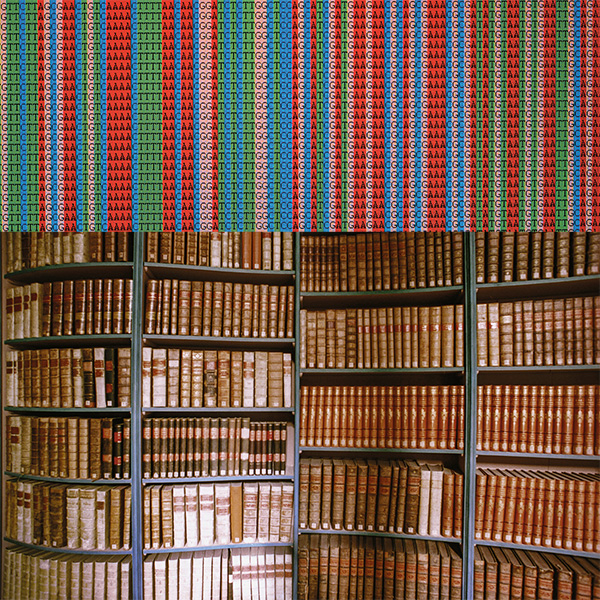DNA hunters helping species conservation
Indigenous frogs and newts are being threatened by invasive species and dwindling habitats. Genetic methods can help us to understand their situation better.

The DNA from this newt’s mouth proves that not even motorways are a hindrance to its species. | Image: S. Brodbeck/WSL.
Nature conservation is hard work. Researchers have to go out into the field – rummaging among the reeds and rushes of muddy ponds, for example, just to try and find a great crested newt. “Such shy species are difficult to find just by going out in the field”, says Benedikt Schmidt, a resident expert at the Coordination Office for the Protection of Amphibians and Reptiles in Switzerland (KARCH). He and his colleagues only manage scarce sightings on their field trips, but they still have to use the information gathered to draw conclusions about the dissemination and migration of the animals.
Now, thanks to molecular genetics, his work should become easier and his research results more reliable. These methods make visible the invisible, and enable him to count the uncountable. Assorted genetic procedures are already being employed in the study of amphibians.
In order to determine the variety of amphibians in a body of water, they now need nothing more than a water sample. The skins of frogs and newts constantly shed cells and secretions, which contain fragments of their genetic material. This environmental DNA (‘e-DNA’ for short) can today be found reliably in water.
The volume of the genetic material is unimaginably small. “Ultimately, you only take a shot glass of water to the lab, so there naturally isn’t much DNA in it. That means you have to work especially cleanly in the lab”, says Schmidt, who also researches at the University of Zurich. But the work is worth it: using these genetic methods, the biodiversity of Swiss ponds can be registered more reliably.
Alien amphibians
The possible applications of this method go far beyond making inventories of animals. Conservation genetics also brings clarity when monitoring the advance of invasive species – such as the water frog. Many water frog populations in Switzerland are no longer pure, but comprise hybrids of indigenous species and others that have come from outside. Sometimes, a pond can even turn out to have nothing but non-native species. But they can be so similar to the indigenous frogs that you can’t tell them apart with the naked eye.
“This is a case of gradual immigration. We’ve long known about it, but we weren’t aware of the extent of it. Investigating the e-DNA has shown that only a third of all Swiss ponds have purely indigenous populations”, says Schmidt. Now the authorities can concentrate their conservation measures in those places where they can truly help the indigenous species, instead of unintentionally promoting the spread of invasive species.
Thanks to conservation genetics, it’s also possible to make more reliable statements about how far animals move about within their habitat. “With species conservation, it’s important to know just what links exist between individual populations”, says Janine Bolliger, a landscape ecologist at the Swiss Federal Institute for Forest, Snow and Landscape Research (WSL). The more individuals encounter each other, the more intermixed their genes become. “It’s especially the small, fragmented populations that will at some point succumb to incest and genetic impoverishment, and this can lead to their extinction”, says Bolliger.
Newt versus motorway
But assessing such cross-linkage requires more than just a water sample, says Rolf Holderegger, the head of the Research Unit for Biodiversity and Conservation Biology at the WSL. He’s been working in conservation genetics there for more than 20 years. “You take a swab of the mucous membrane in a frog’s mouth. Then you investigate between 10 and 15 sections of its DNA”, says Holderegger.
Such investigations can reveal for the first-ever time the degree of interaction between different populations. “We can find out which individuals have moved where”, says Bolliger. If a newt or a frog sets off on its travels, it’ll produce offspring on the way. In this manner, it leaves behind a kind of genetic slime trail that goes right across the countryside.
This means, for example, that you can investigate whether roads are insurmountable obstacles to amphibians, and whether or not they have an impact on the survival chances of the population. For a study conducted near Aarau (available here, in German only), Bolliger and her colleagues took swabs from 2,000 alpine newts in over 100 ponds.
Astonishingly, the genetic analysis in this case provided an all-clear signal. “The animals that lived in the town were genetically quite different from those outside the town, but there was a fluid transition between the two of them”, says Bolliger. In other words, Alpine newts are successfully moving from one side of the motorway to the other, presumably through small culverts or underpasses.
Genetic sets for environmental offices
Despite these new possibilities, many environmental offices and cantonal nature protection authorities have up to now shied away from engaging with genetics. This might be because the procedures involved weren’t really ready until just a few years ago, or because their employees have simply never had to engage with genetics before. Robert Meier works at the environmental office Arnal in eastern Switzerland, and he’s trying to reduce people’s reservations. To this end, together with the federal authorities and several cantons, he’s developed a set of tools (available here in German) that contains the necessary materials and explains to novices how to take genetic samples. The tests and the subsequent evaluations are then carried out by a specialist laboratory.
This year, between 50 and 100 sets will be sold. The cost of an analysis is about CHF 250. That means less than CHF 800 per pond. “If you wanted to determine the diversity of species by field work alone, you’d soon pay a similar amount for the number of hours involved”, says Meier.
Traditional field trips aren’t going to be replaced by conservation genetics any time soon. Holderegger from the WSL sees them more as a complement to field work, because a biologist out in the field will also inspect the general state of a body of water, or will observe shifts in the environment that could have an impact on species diversity. Species that live in shrubs and trees, such as the common tree frog, for example, would slip through the metaphorical net of the e-DNA hunters. “In those cases, a water probe wouldn’t help much”, says Holderegger.
Atlant Bieri is a freelance science journalist in Pfäffikon (canton of Zurich).




